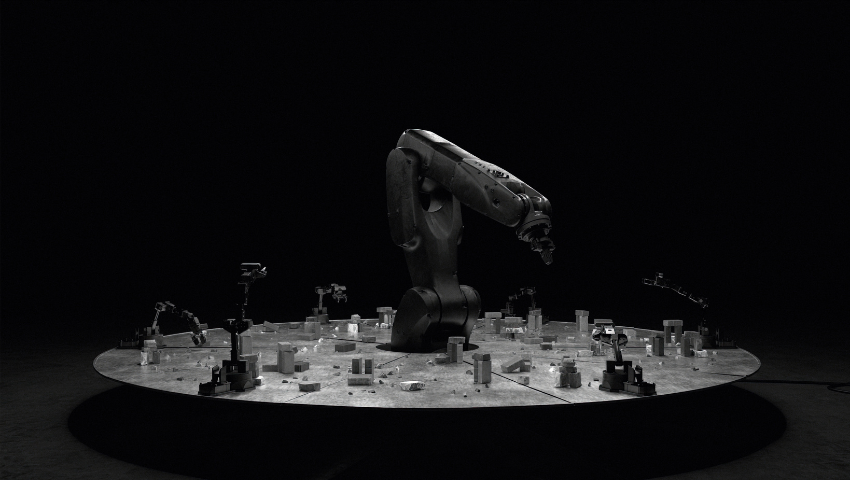Image Credit: Kachi Chan
At SIGGRAPH 2024, Kachi Chan offered attendees an opportunity to view societal and political issues in a unique way. Kachi’s SIGGRAPH 2024 Art Papers submission, “‘Sisyphus’: A Robotic Vignette of Systemic Conflict and Democratic Endeavors”, showcases the symbolic interplay between humans and machines. Grab your notebooks and prepare for a deep dive into this amazing work.
SIGGRAPH: Your project, “‘Sisyphus’: A Robotic Vignette of Systemic Conflict and Democratic Endeavors”, carries a strong message. Can you talk about what inspired you to develop this work?
Kachi Chan (KC): The inspiration for the “Sisyphus” installation came from my experiences living in London and observing the constant debates, discussions, and arguments happening around important societal and political issues. I found these ongoing conversations between different sides to be very interesting, as neither side would ever fully concede or reach a definitive resolution. Instead, there was an unending back-and-forth with the relative power and influence of each side shifting over time.
I was motivated to depict these systemic conflicts and democratic struggles using non-human entities — the large “Destructor” robot symbolizing oppressive authority, and the smaller “Constructor” robots representing resilient collective resistance. As someone with an animation background, I was intrigued by the uncanny movements of the large robotic arms at my university, UCL, and felt they would be the perfect “characters” to embody this dynamic of perpetual confrontation.
SIGGRAPH: Speak about the physical creation for this work. How did you go about developing the robotic piece? Did you encounter any challenges along the way?
KC: Creating the physical “Sisyphus” installation was extremely challenging for me, coming from an animation background. For the smaller “Constructor” robots, I had to start from scratch, designing and 3D printing the joints and using servo motors to build a functional robotic arm capable of the precise pick-and-place movements I envisioned. This process was arduous, with many prototypes and iterations before I could achieve the smooth, consistent motion I wanted. Debugging the code and getting the robotic arm to operate reliably was a true “Sisyphean” task.
The larger “Destructor” robot, being a Kuka industrial arm, was slightly easier to work with, as it came with a more robust operating system. However, integrating the two robots to function in a synchronized, confrontational manner was still a major technical hurdle that required significant support from my supervisor Ruairi Glynn, Phaedra Shanbaum, Parker Heyl, and the technical staff at UCL.
SIGGRAPH: What inspired your team to submit this work to the SIGGRAPH 2024 Art Papers program? Why was it important to share this message in this space?
KC: We felt that submitting “Sisyphus” to the SIGGRAPH 2024 Art Papers program would be an excellent opportunity to share this work with a broader audience of artists, technologists, and researchers interested in the intersection of robotics, interactive art, and sociopolitical commentary. The SIGGRAPH community is known for its cutting-edge explorations of technology in creative expression, making it an ideal platform to present a work that so deeply engages with themes of systemic conflict, democratic resistance, and the symbolic interplay between humans and machines.
SIGGRAPH: What do you hope the SIGGRAPH 2024 audience took away, personally or professionally, from your Art Papers contribution?
KC: Personally, I hope the SIGGRAPH audience would be inspired by the “Sisyphus” installation to reflect on the nature of futility, resistance, and the ongoing negotiation of power dynamics in society. I want them to see the resilience and adaptive capacity of the “Constructor” robots as a metaphor for the indomitable human spirit, refusing to be cowed by oppressive forces.
Professionally, I hope this work encourages the SIGGRAPH community to consider how robotic and interactive art can be leveraged to explore complex sociopolitical themes and prompt deeper contemplation of the human condition.
SIGGRAPH: What is next for your work? Do you see this contribution evolving or do you plan to explore other avenues of artistic expression?
KC: I am eager to continue exploring the intersection of robotics, interactive art, and sociopolitical commentary. While I am proud of the “Sisyphus” installation, I see it as just the beginning of a broader artistic practice that leverages technology to illuminate the nuances of human struggle, resistance, and the dynamic negotiation of power.
Some potential avenues I am interested in pursuing include creating robotic art installations that address themes of marginalization and decolonization. I am also fascinated by the idea of using cybernetic systems and feedback loops to create art that evolves and adapts over time, mirroring the dynamic nature of social and political change. My goal is to continue pushing the boundaries of what technology plus art can achieve in terms of sparking critical reflection and inspiring audiences to reimagine the world around them.
If you feel inspired after reading this blog, you should submit your work to SIGGRAPH 2025. Submissions for all programs, including Art Papers, are opening soon. Be sure to bookmark the SIGGRAPH 2025 website and check back frequently as programs open their submissions process.

Kachi Chan is an artist and researcher who bridges the physical and digital worlds through digital realities, computational design, and robotics. His work leverages cultural informatics to artistically address social issues, highlighting underrepresented perspectives. Kachi’s research-driven artistry has been showcased at prominent events such as Ars Electronica Festival, ISEA International, SIGGRAPH, and the London Design Festival. He is currently an Assistant Professor at Hong Kong Baptist University, where he teaches media art theories and practices. Kachi holds a Master of Architecture degree from Bartlett, UCL.



